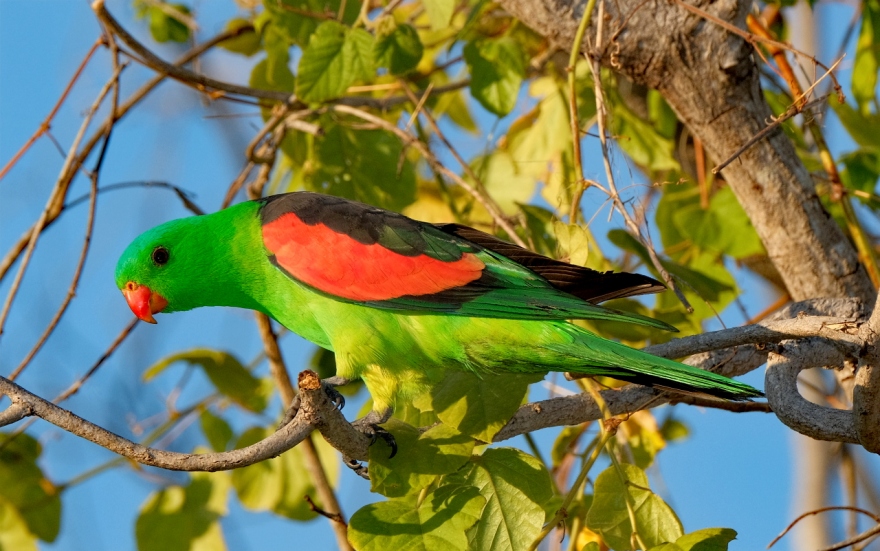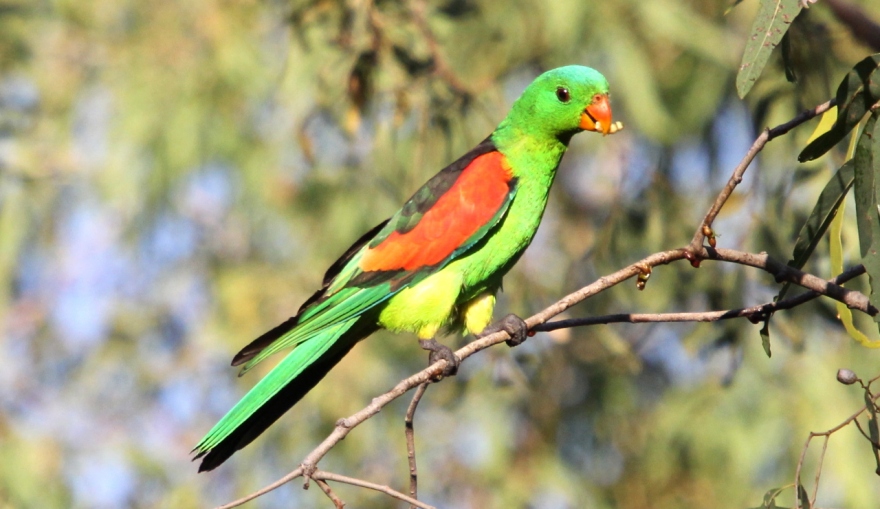The red-winged parrot—often called the crimson-winged parrot in aviculture—is a medium-sized parrot found throughout northern and north-eastern Australia and the southernmost parts of New Guinea. They are infrequently seen in aviculture and are much less popular than the closely-related king parrot, but can usually be sourced from breeders or dealers with little difficulty.

Housing & Compatibility
Red-winged parrots should be housed as one pair per aviary, in an aviary that’s at least three metres long. They do best in a traditional aviary that offers a secluded area for privacy.
They are enthusiastic chewers and need to be provided with natural non-toxic branches and perches to provide stimulation. Seeding or flowering branches are especially enjoyed, but will need to be replaced often.
Red-winged parrots like to nest in a shaded area of the aviary, in a nestbox or hollow log that’s well above ground level. Provided a small amount of shelter is necessary for good breeding results.
Diet & Feeding
A quality small parrot seed mix forms the basis of the red-winged parrot’s diet. Seed should be stored in an airtight plastic container to prevent exposure to vermin and moisture. It can be soaked or sprouted to improve its nutritional value.
A good diet includes a mix of fruits, nuts, leafy greens, and vegetables. Fresh foods including apple, pear, corn, silverbeet, pak choy, kale, and endive are particularly enjoyed. They also appreciate the inclusion of nuts, especially plain almonds or a commercially produced fruit and nut mix.
Many breeders prefer to feed parrot pellets instead of seed. Pellets provide a more balanced intake of vitamins and minerals and produce less waste. Commercial supplements such as egg & biscuit mix can be added to the diet to provide additional protein during the breeding season.
Do not feed anything from the list of forbidden foods.

Breeding Red-Winged Parrots
A compatible pair of red-winged parrots will breed from spring through to early summer.
The pair should be offered a variety of different nest boxes in different sizes and locations. The box should be positioned at a slight angle and have a substrate of wood shavings or saw dust. Once the hen has made her nest box selection, the other boxes should be removed.
The hen will lay 4-6 eggs, usually one every second day, and then incubate them alone for approximately three weeks. After hatching, the chicks will take about five weeks to emerge from the nest, and be fully independent three weeks later.
The young birds will need to be moved to a different aviary once they reach maturity, as the parents—particularly the male—can be aggressive towards them.
The hen may produce up to two clutches per year. Further breeding beyond this should be discouraged, as overbreeding can be damaging to the health of the hen bird.
Mutations
Mutation red-winged parrots have been produced, but are very rare and should not be considered as “established.” Dilute, olive, and cinnamon birds turn up occasionally, and there are infrequent claims of yellow or opaline birds being produced .
Be wary of supposed red-winged mutations that are actually red-winged/king parrot hybrids.
Sexing
Easy to visually sex. Females are much duller in colour than the males, have a smaller red patch, and have no black feathers on their wings.
Health & Lifespan
A strict worm control regime and regular preventative treatment for bacterial and fungal infections is critical to ensure the long-term health of any bird.
Sources conflict on the expected lifespan of a red-winged parrot. Some state they will live for 15 years, while others claim they can live for up to 50 years.
Their closest relatives—the Australian king parrot—will typically live for 25 years in captivity, so it’s reasonable to assume that red-winged parrots can live around this long as well.
SEXING
I would add that, until the first moult, immature males look similar to the female, with only a small area of red on the edge of the wing. If getting immature birds, surgical or DNA sexing might be prudent.